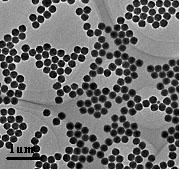
Researchers form Institute of Process Engineering, Chinese Academy of Sciences (IPE) developed a new method to synthesize homogeneous and mono-disperse CeO2 nanosphere by two-step hydrothermal process. Led by Prof. CHEN Yunfa, researchers describe their technique in the journal Journal of Nanoparticle Research (volume 13, number 10, 4969-4978).
CeO2 belongs to face-centered cubic structure and characteristic planes of CeO2 ((111), (110) and (100) planes) possess different surface energies, which determine the different growth rate of crystal planes. Therefore, sphere crystallite is difficult to be synthesized without surfactant. In addition, the degrees of dispersion and homogeneity for CeO2 nanosphere obtained through common method are not easy to control.
In the two-step hydrothermal process, crystallization and ripening were regarded as two independent stages. After the first hydrothermal process, the upper transparent solution obtained through centrifugation contained a large number of CeO2 crystal seeds, indicating that crystallization has taken place in this stage. In the second hydrothermal process, these seeds started to grow up and ripened into homogeneous spheres finally (see Figure 1, 2). In the whole reaction, surfactant Poly(vinylpyrrolidone) (PVP) played also important part in the formation of CeO2 nanospheres, which could facilitate the oriented aggregation of small CeO2 nanoparticles.

Figure 1 TEM image of homogeneous and mono-disperse CeO2 nanosphere (Image by IPE)

Figure 2 the formation mechanism of CeO2-NS-TS (Image by IPE)

86-10-68597521 (day)
86-10-68597289 (night)

52 Sanlihe Rd., Xicheng District,
Beijing, China (100864)

